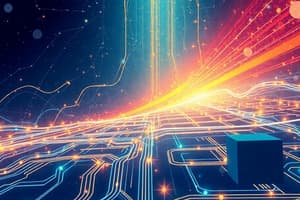Podcast
Questions and Answers
What is the primary function of the World Wide Web?
What is the primary function of the World Wide Web?
- To store multimedia resources on a local device
- To provide a way to exchange information between computers (correct)
- To connect devices only through wired connections
- To limit access to specific websites
What is an internet domain?
What is an internet domain?
- A name that helps users access a website (correct)
- A type of broadband connection
- A physical location of a server
- A method for securing website data
Which of the following is a disadvantage of wireless connections?
Which of the following is a disadvantage of wireless connections?
- More reliable than wired connections
- Generally faster than wired connections
- Vulnerable to interference and security risks (correct)
- Requires physical cables for connection
What is a characteristic of wired connections?
What is a characteristic of wired connections?
How do domains simplify internet navigation?
How do domains simplify internet navigation?
What defines a network?
What defines a network?
Which of the following is NOT an advantage of wireless connections?
Which of the following is NOT an advantage of wireless connections?
Which type of network is designed for a small area?
Which type of network is designed for a small area?
What does 'mobility' refer to in the context of wireless connections?
What does 'mobility' refer to in the context of wireless connections?
Which of the following is an example of a LAN?
Which of the following is an example of a LAN?
What typically affects the reliability of wireless connections?
What typically affects the reliability of wireless connections?
Which type of connection is generally considered more stable?
Which type of connection is generally considered more stable?
What does the acronym IP stand for?
What does the acronym IP stand for?
What do Wi-Fi and Bluetooth have in common?
What do Wi-Fi and Bluetooth have in common?
What is an example of a WAN?
What is an example of a WAN?
Which statement about IP addresses is true?
Which statement about IP addresses is true?
Which of the following describes the World Wide Web?
Which of the following describes the World Wide Web?
How can a smartphone function in a PAN?
How can a smartphone function in a PAN?
What is a primary use of a WAN?
What is a primary use of a WAN?
What type of connections do personal area networks typically involve?
What type of connections do personal area networks typically involve?
Flashcards
Network
Network
A group of connected devices, people, or systems that communicate and share information.
PAN
PAN
A small network connecting devices close to a single user.
LAN
LAN
A network in a small area like a home, school, or office.
WAN
WAN
Signup and view all the flashcards
Internet
Internet
Signup and view all the flashcards
IP address
IP address
Signup and view all the flashcards
IP
IP
Signup and view all the flashcards
WWW
WWW
Signup and view all the flashcards
Internet Domain
Internet Domain
Signup and view all the flashcards
Internet Protocol (IP)
Internet Protocol (IP)
Signup and view all the flashcards
World Wide Web
World Wide Web
Signup and view all the flashcards
Wired Connection
Wired Connection
Signup and view all the flashcards
Wireless Connection
Wireless Connection
Signup and view all the flashcards
Wireless Connection Advantage
Wireless Connection Advantage
Signup and view all the flashcards
Wireless Connection Disadvantage
Wireless Connection Disadvantage
Signup and view all the flashcards
Wired Connection Advantage
Wired Connection Advantage
Signup and view all the flashcards
Network Connection
Network Connection
Signup and view all the flashcards
Mobility (Wireless)
Mobility (Wireless)
Signup and view all the flashcards
Interference (Wireless)
Interference (Wireless)
Signup and view all the flashcards
Study Notes
Network Basics
- A network connects devices, people, or systems to communicate and share information.
Network Types
-
PAN (Personal Area Network): A small network designed to connect devices close to a single user.
- Examples: smartwatch and smartphone, laptop and phone.
- Uses: file sharing between devices, internet sharing via mobile hotspot.
-
LAN (Local Area Network): A network in a small area like a home, school, or office.
- Examples: computers in a school lab sharing a printer, devices connected to a home Wi-Fi.
- Uses: sharing files or homework, printing documents from multiple computers.
-
WAN (Wide Area Network): Connects computers over large areas like cities or countries.
- Examples: the internet, banks linking branches nationwide.
- Uses: watching videos, sending emails, making video calls.
Internet
- The Internet is a vast global network connecting computers and devices worldwide.
IP Address
- An IP address is a unique numerical label that identifies a device on the internet or a local network.
- An example is 192.168.1.1.
- IP stands for Internet Protocol.
WWW
- WWW stands for World Wide Web.
- It's a way of exchanging information between computers on the internet.
- It contains interactive multimedia resources.
Internet Domain
- An internet domain is a text-based address (like example.com) that helps users access a website.
- This is easier to remember than a complex IP address.
Network Connections
-
Wired Connection: Uses physical cables (e.g., Ethernet, fiber optic cables) to link devices to the internet.
- Advantages: Stability, Reliability, Faster Speeds, Security, Low Latency, No Signal Interference, Power Efficiency
- Disadvantages: Limited Mobility, Installation complexity, Clutter.
-
Wireless Connection: Uses radio waves to link devices to the internet.
- Examples: Wi-Fi, Bluetooth
- Advantages: Mobility, Convenience, No Cable
- Disadvantages: Slower Speed, Interference, Security Risks
Exit Ticket Questions
- Which Connection Type is better for home use? Why?
- Have you experienced any issues with either connection type?
Studying That Suits You
Use AI to generate personalized quizzes and flashcards to suit your learning preferences.




